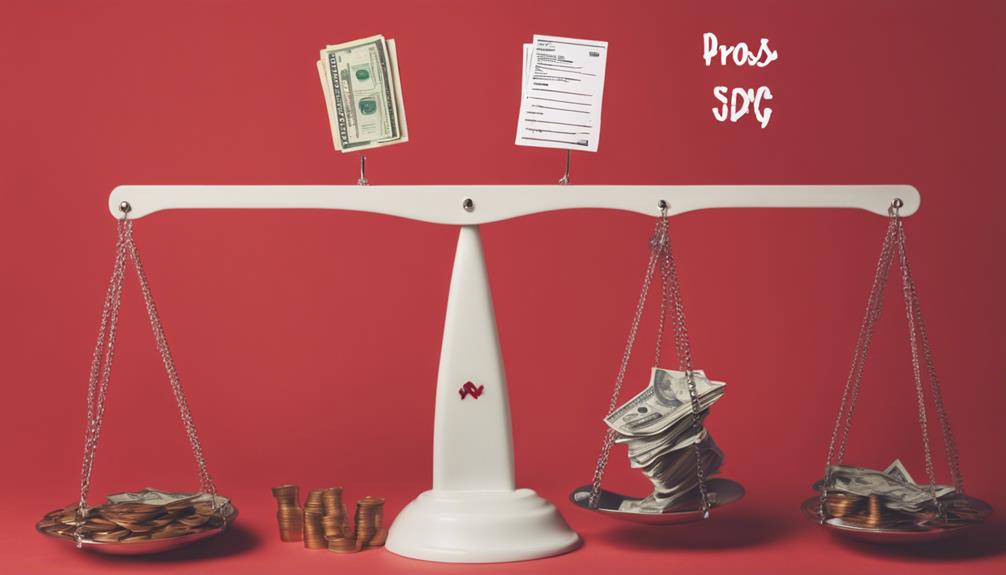California’s mandatory retirement plan requirements are managed by the CalSavers program. Businesses with five or more employees must enroll by June 30, 2022, while those with 1-4 employees have until December 31, 2025. Workers, including sole proprietors, are eligible to join with contributions starting at $10. The program emphasizes financial stability, providing investment choices such as Money Market Fund and Target-Date Funds. Failing to comply can result in financial penalties, making prompt registration crucial. Understanding these responsibilities is essential for meeting compliance and building successful retirement savings. Delve deeper to fully comprehend California’s retirement plan requirements.
Key Takeaways
- Employers with 5+ employees must offer a retirement plan or join CalSavers.
- Registration deadlines vary based on the number of employees.
- Understanding and meeting deadlines prevent financial penalties.
- Complying ensures adherence to California's mandatory retirement plan regulations.
- Prompt action is vital to avoid fines and ensure regulatory compliance.
CalSavers Program Overview
In the CalSavers Program Overview, we introduce California's retirement savings initiative designed for private-sector workers lacking workplace retirement plans. CalSavers targets small businesses, including those with at least one employee. Employers establish an Individual Retirement Account (IRA) for each eligible employee, enabling automatic and adjustable payroll deductions. Contributions are directed into a Roth IRA, with a $7,000 annual limit set for 2024.
Within the program, employees have access to investment options such as the Money Market Fund and Target-Date Funds. This setup allows for flexibility and choice in how retirement savings are managed. California's focus on providing a simple and effective solution for employees without traditional retirement benefits showcases a commitment to financial security.
Employer Registration Requirements

We'll now discuss the employer registration requirements for CalSavers, a mandatory retirement plan in California. Employers with 5 or more employees must register by June 30, 2022, while those with 1-4 employees have until December 31, 2025, to comply.
Let's explore the registration process overview and clarify the responsibilities that employers must adhere to under CalSavers.
Registration Process Overview
To adhere to California's mandatory retirement plan requirements, employers with 5 or more employees must complete the registration process for CalSavers by June 30, 2022. For small businesses with 1-4 employees, the deadline extends until December 31, 2025. The registration process is vital for facilitating retirement savings for employees. Timely registration is essential to avoid financial penalties. Below is an overview of the registration process:
| Registration Steps | Description | Importance |
|---|---|---|
| Step 1 | Create CalSavers account | Initiate registration |
| Step 2 | Enter employer information | Provide necessary details |
| Step 3 | Enroll employees | Facilitate savings |
| Step 4 | Set up contribution options | Customize savings plan |
Employer Responsibilities Clarified
Clarifying employer registration requirements for CalSavers mandates proactive engagement with the registration process to guarantee timely compliance. Employers with 5 or more employees must register for the CalSavers program by June 30, 2023, while businesses with 1 to 4 employees have until December 31, 2025, to complete their registration.
Failure to meet these registration deadlines can result in financial penalties, so it's essential for employers to adhere to the CalSavers mandate. Newly impacted employers should register promptly by the end of the calendar year to make certain compliance with mandatory retirement plan requirements.
CalSavers aims to simplify the registration process, making it easier for employers to fulfill their responsibilities and avoid potential penalties.
Employee Participation Guidelines
Employee participation guidelines for CalSavers require eligible individuals to meet specific criteria related to age, employment status, and tax documentation. To participate in this innovative retirement plan, employees must be of eligible age, have a valid employment status, and possess the necessary tax documentation, such as a Form W-2. This guarantees that those contributing to CalSavers are compliant with the program's requirements and are set up for successful retirement savings through a Roth IRA funded by convenient payroll deductions.
Additionally, sole proprietors, partners in eligible businesses, and even independent contractors meeting age and income source requirements can also take advantage of CalSavers. With contributions starting as low as $10, CalSavers promotes inclusivity by catering to a wide range of income levels, making it accessible for employees across various financial backgrounds. By adhering to these participation guidelines, individuals can proactively secure their financial futures while enjoying the ease of automatic contributions facilitated by their employers.
Portability of Savings

CalSavers offers the convenience of transferring retirement funds between jobs, ensuring accessibility to savings.
Employees can maintain their CalSavers account even when changing employers, providing flexibility in investment options.
This feature allows individuals to continue building their retirement savings steadily, promoting financial security for the long term.
Transfer Retirement Funds
Ensuring seamless transfer of retirement funds between different employers, the portability feature in CalSavers allows for easy transfer of savings. This option is a game-changer for employees, fostering savings continuity and financial security.
With the ability to move retirement funds effortlessly, workers can navigate through job changes without worrying about losing their hard-earned savings. The portability of savings feature not only offers convenience but also promotes long-term financial planning.
Through CalSavers' portability option, employees can efficiently consolidate and manage their retirement funds, ensuring a smooth shift and encouraging a proactive approach to securing their financial future. This innovative feature empowers individuals to take control of their retirement savings, setting the stage for a stable financial outlook.
Accessibility of Savings
Enhancing financial flexibility and continuity, the portability feature in CalSavers facilitates seamless transfer of retirement savings between different employers. This means employees can easily manage and track their savings even when changing between jobs.
The portability of savings guarantees that individuals can maintain and continue building their retirement funds regardless of job changes, providing a sense of security. Particularly beneficial for industries with high turnover rates, this feature offers flexibility for participants in the CalSavers program.
With the ability to carry forward their accumulated savings, employees can rest assured that their retirement goals remain on track, no matter where their career path leads.
Investment Options Flexibility
By offering a range of investment options with portability of savings, employees participating in the CalSavers program can seamlessly transfer their retirement funds between different job opportunities. Within CalSavers, employees have access to various investment options such as Target Retirement Funds, ESG funds, and core bond funds, all aimed at providing flexibility and growth for their retirement funds. The Roth IRA structure of CalSavers also offers tax benefits, allowing for tax-free withdrawals during retirement. This investment options flexibility and portability of savings make sure that employees can continue to build a secure retirement, even amidst job changes or shifts.
| Investment Options | Benefits |
|---|---|
| Target Retirement Funds | Diversification and simplicity |
| ESG Funds | Socially responsible investing |
| Core Bond Funds | Stability and income generation |
| Roth IRA Structure | Tax benefits and tax-free withdrawals |
Alternative Retirement Plan Options

Exploring alternative retirement plan options can provide employers in California with flexibility and choice when considering their employees' financial futures. Employers have the option to choose from various qualified plans like the workplace retirement plan, SIMPLE IRA, and SEP plans.
Safe Harbor 401(k) plans, for instance, offer the advantage of eliminating IRS testing requirements, although they do require fixed employer contributions. It's important for employers to compare these retirement options against CalSavers to make well-informed decisions.
Guidance from the EBSA and IRS can assist in selecting the right retirement plan that aligns with the employer's fiduciary responsibility and the employees' financial security. Before deciding on coverage, employers should carefully assess the pros and cons of different retirement options to make sure they meet the needs of their workforce and comply with regulations.
Compliance Deadlines for Businesses

Businesses in California must adhere to specific compliance deadlines regarding the enrollment in retirement plans. These deadlines encompass key aspects such as enrollment, employer contribution requirements, and employee notification obligations.
It's important for businesses to meet these deadlines to avoid potential financial penalties and uphold compliance with the state's mandatory retirement plan requirements.
Deadline for Enrollment
Ensuring compliance with CalSavers' enrollment deadlines is essential for businesses in California looking to meet retirement savings requirements. Employers with 5 or more employees must enroll by June 30, 2023, while businesses with 1-4 employees have until December 31, 2025, to register.
Missing these deadlines may result in penalties. CalSavers sets these deadlines to boost workers' retirement savings participation. It's important for businesses to understand and meet these enrollment deadlines to avoid any financial repercussions and ensure their employees' future financial security.
Employer Contribution Requirements
To comply with California's mandate regarding employer contribution requirements, businesses with 5 or more employees must offer a retirement plan or join CalSavers by June 30, 2023. This compliance deadline aims to guarantee that employees have access to retirement savings options.
Companies can also opt for exemptions if they already have a qualified retirement plan like a 401(k) or 403(b), but they need to apply for an exemption with CalSavers. Financial penalties for non-compliance start at $250 per eligible employee.
This requirement now applies to businesses with at least 1 employee, effective January 1, 2023, expanding the scope. Smaller businesses with 1-4 employees have until December 31, 2025, to register for CalSavers and meet the compliance deadline.
Employee Notification Obligations
After addressing the employer contribution requirements, our focus now shifts to the compliance deadlines for businesses regarding employee notification obligations.
Employers with 5 or more employees must offer a retirement plan or register with CalSavers by June 30, 2023. The deadline for registration varies based on the size of the business, with those having 1-4 employees having until December 31, 2025, to comply.
It's important to note that compliance with CalSavers requirements is mandatory for eligible employers. Missing the registration deadlines can result in penalties, underscoring the significance of timely compliance.
It's essential for employers to be aware of these deadlines and take the necessary steps to avoid potential penalties while fulfilling their obligations.
Penalties for Non-Compliance

Non-compliant employers in California can expect fines of $250 per eligible employee under the CalSavers mandate. If businesses persist in non-compliance, they may face an additional penalty of $500 per eligible employee. Upon receiving notice of non-compliance, employers have a 90-day grace period to rectify the situation. It is vital for companies that are not yet compliant to take immediate action to avoid these penalties, as they are enforced to guarantee adherence to the state's mandatory retirement plan requirements.
| Penalties for Non-Compliance | Amount |
|---|---|
| Initial Fine per Employee | $250 |
| Additional Fine per Employee | $500 |
| Grace Period | 90 days |
| Enforcement | Mandatory |
These fines serve as a mechanism to encourage compliance with the CalSavers mandate, promoting the financial well-being of employees and ensuring that businesses fulfill their obligations towards retirement planning.
Investment Options Available

Participants in CalSavers have access to a variety of investment options, including a Money Market Fund and Target-Date Funds. The Money Market Fund offers stability, while Target-Date Funds are tailored to your retirement timeline. These funds automatically adjust their investment mix based on your projected retirement date, providing a balanced approach to growing your savings over time.
CalSavers' investment options are designed to give you flexibility in aligning with your risk tolerance and retirement goals. Whether you prefer a safer option like the Money Market Fund or a more dynamic approach with Target-Date Funds, CalSavers caters to your preferences. By considering your risk tolerance and retirement objectives, you can make informed decisions to secure your financial future.
CalSavers' diverse investment options empower you to take charge of your retirement planning, ensuring that your investments align with your unique financial aspirations.
Pros and Cons for Employers

Moving on to the discussion of Pros and Cons for Employers, CalSavers offers distinct advantages and considerations for businesses managing retirement plan requirements in California.
For small business owners, the state-run retirement savings program, CalSavers, presents a convenient option as it's required for businesses that don't offer their own retirement savings plan. One significant benefit is that CalSavers eliminates employer fees and relieves employers of fiduciary responsibility. Additionally, the program provides a range of investment options at low costs, making it an attractive choice for businesses looking to support their employees' financial futures.
However, employees must pay fees between $0.83 to $0.95 for every $100 saved in CalSavers. Additionally, statistics show that 58% of funded accounts have balances of $500 or less, and there's a 30% opt-out rate among participants. Small business owners should compare CalSavers with other retirement options like 401(k) plans to select the best coverage for their employees.
Employer Responsibilities Under Calsavers

Employers with five or more California-based employees must either offer a retirement plan or enroll in CalSavers by the specified deadline. It's important for businesses to understand their employer responsibilities under CalSavers to guarantee compliance with California's mandatory retirement plan requirements.
The registration deadline varies depending on the number of employees, and failure to register on time can lead to financial penalties. For businesses with 1-4 employees, the registration deadline is December 31, 2025. Employers need to act promptly to avoid potential fines, which can start at $250 per eligible employee and increase if non-compliance persists.
Frequently Asked Questions
What Are the Requirements for Retirement in California?
When it comes to retirement in California, businesses with 5+ employees in the state must offer a retirement plan as per California law. This requirement is aimed at improving retirement readiness among workers.
Eligibility is based on the average number of employees reported. Non-compliance can lead to penalties.
The law has a three-year implementation period with staggered deadlines for compliance.
How Does the Calsavers Program Work?
The CalSavers program simplifies retirement saving by setting up IRAs for eligible employees with automatic contributions via payroll deductions. Contributions are placed in a Roth IRA with a $7,000 annual limit in 2024, offering investment options like a Money Market Fund and Target-Date Funds.
Employers must meet registration deadlines to avoid penalties. It's a straightforward way for employees to save for retirement with ease.
What Is the Downside to Calsavers?
Considering the downside to CalSavers includes low account balances, fees ranging from 0.825% to 0.99%, a 30% opt-out rate, contribution limits for Roth IRAs, and fees between $0.83 and $0.95 per $100 saved.
These factors can impact long-term savings growth and may not be suitable for everyone. It's crucial to evaluate these aspects when assessing the program's effectiveness for retirement planning.
What Are the Retirement Plan Requirements?
Retirement plan requirements in California mandate businesses with 5+ employees to provide a retirement plan or join CalSavers by set deadlines.
Companies with one employee must comply with CalSavers from January 1, 2023, while small businesses with 1-4 employees have until December 31, 2025, to register.
Exemptions apply to those with existing qualified retirement plans like 401(k) or 403(b).
Failure to comply can lead to fines starting at $250 per eligible employee.
Conclusion
To wrap up, it's essential for employers to understand and comply with California's mandatory retirement plan requirements. While it may seem like a hassle, ensuring your employees have a secure financial future is vital.
By participating in programs like CalSavers, you're not only meeting legal obligations but also providing a valuable benefit to your workforce. Remember, taking care of your employees' retirement needs can lead to a more loyal and satisfied team in the long run.










